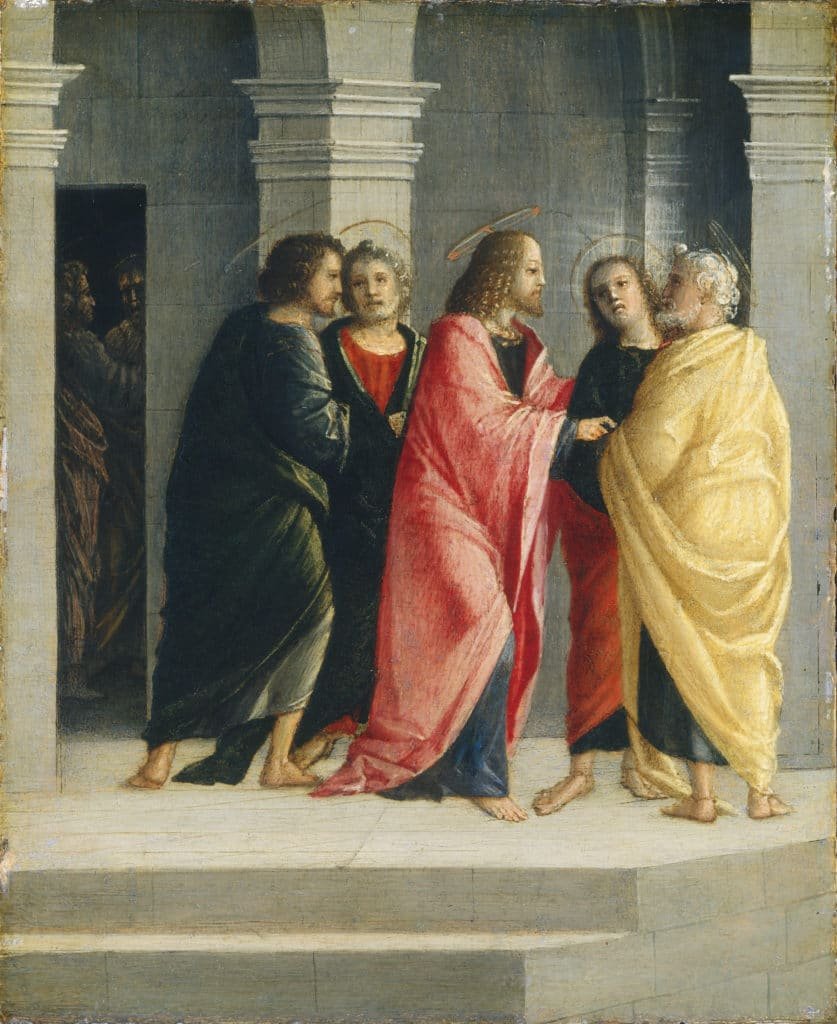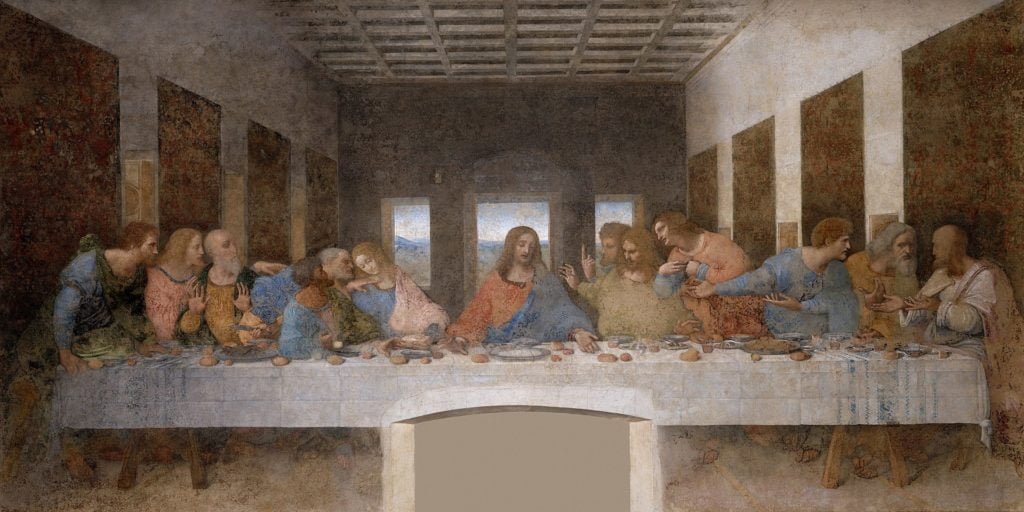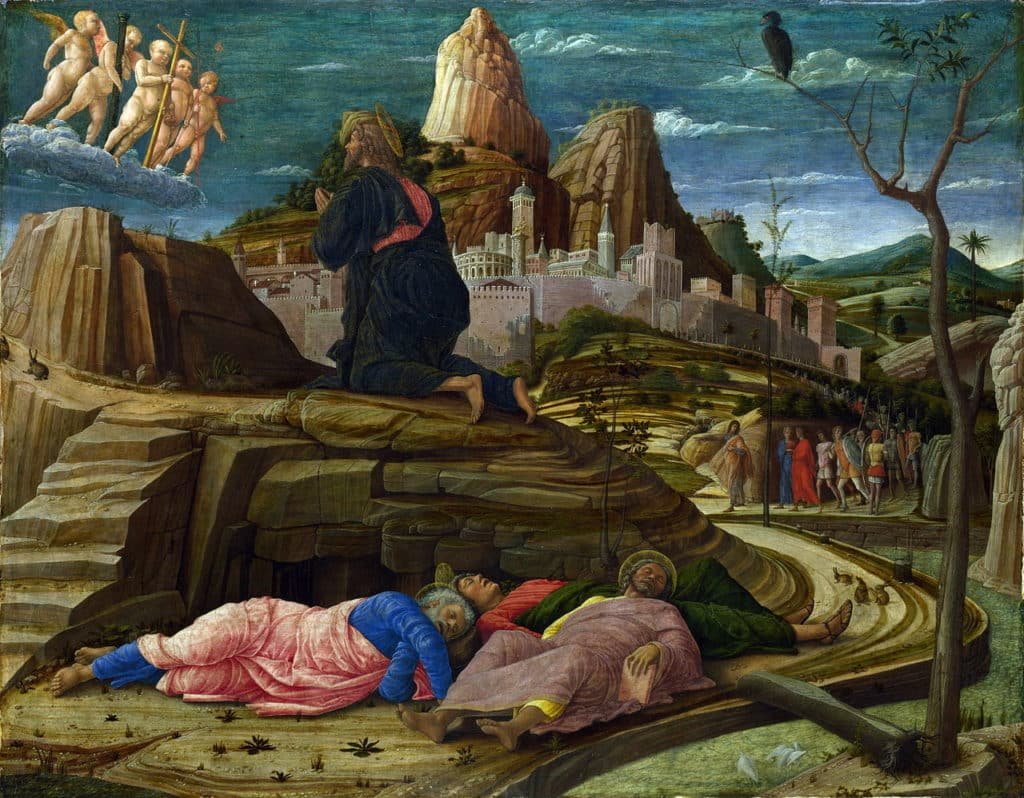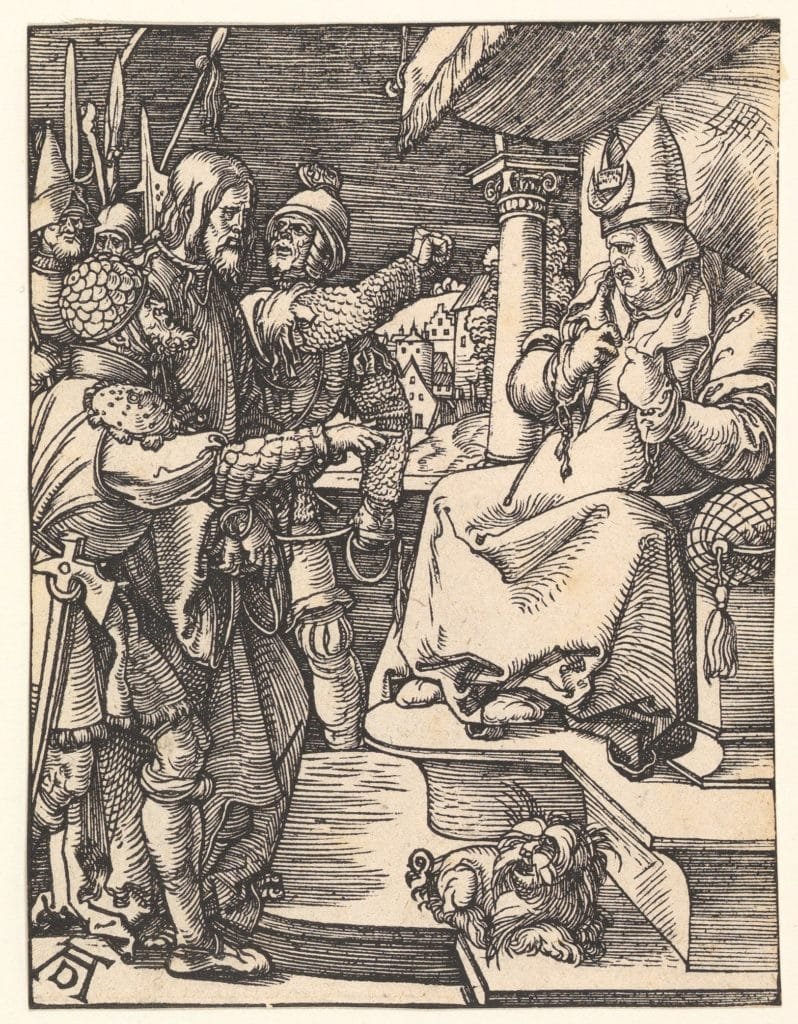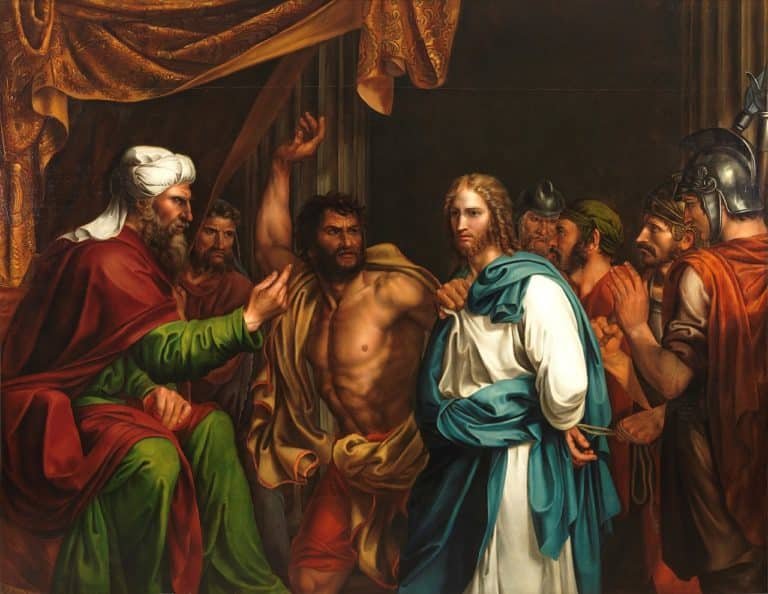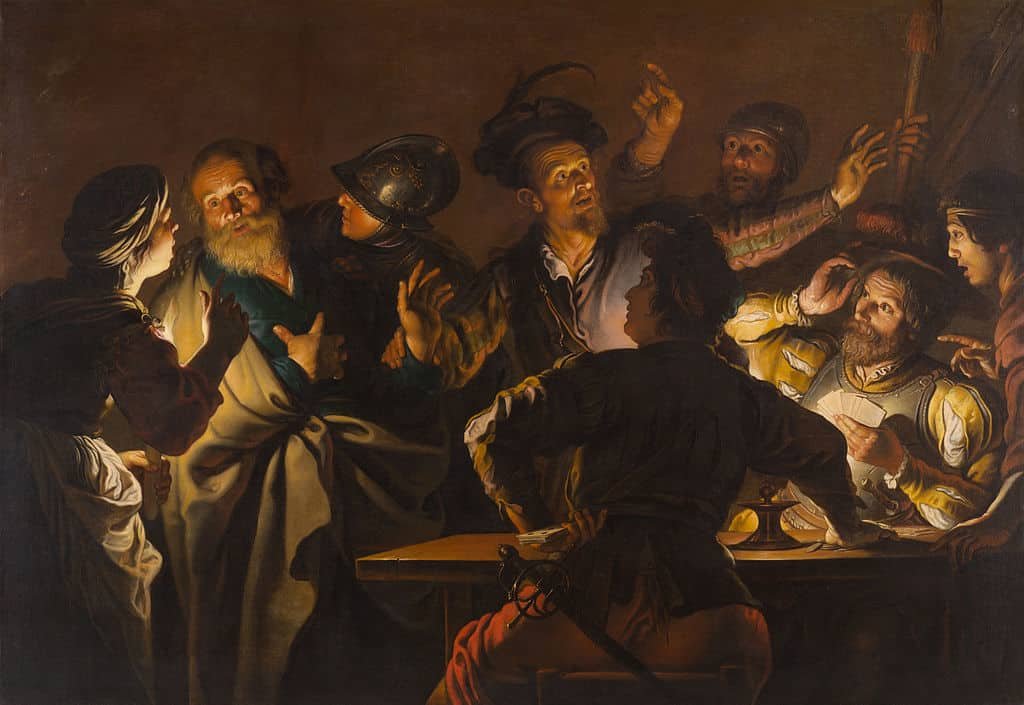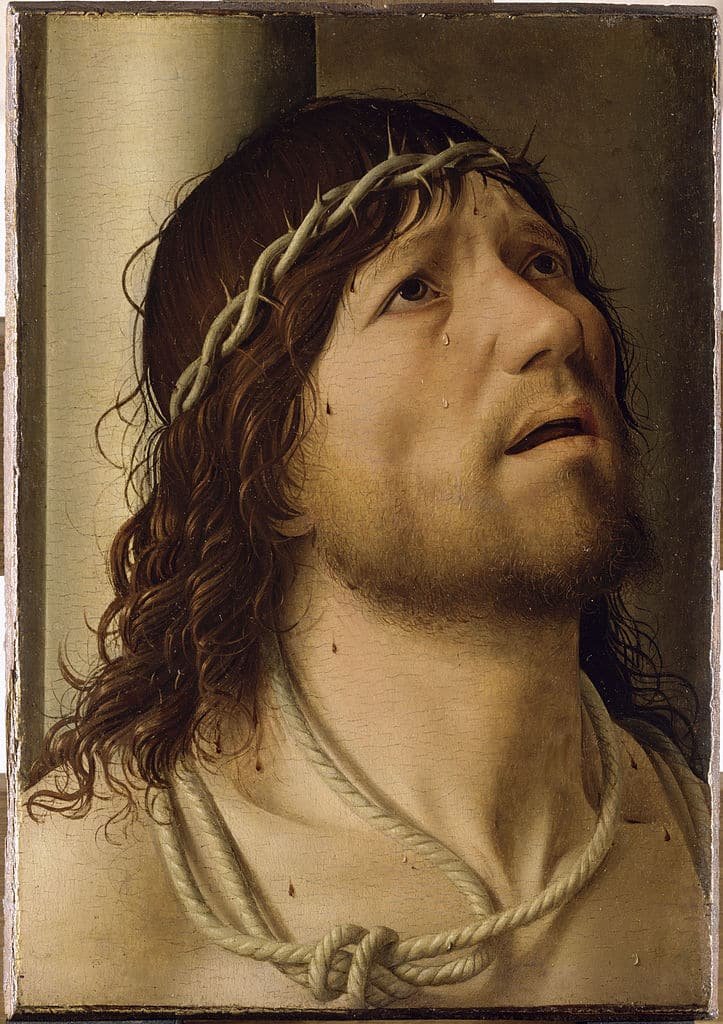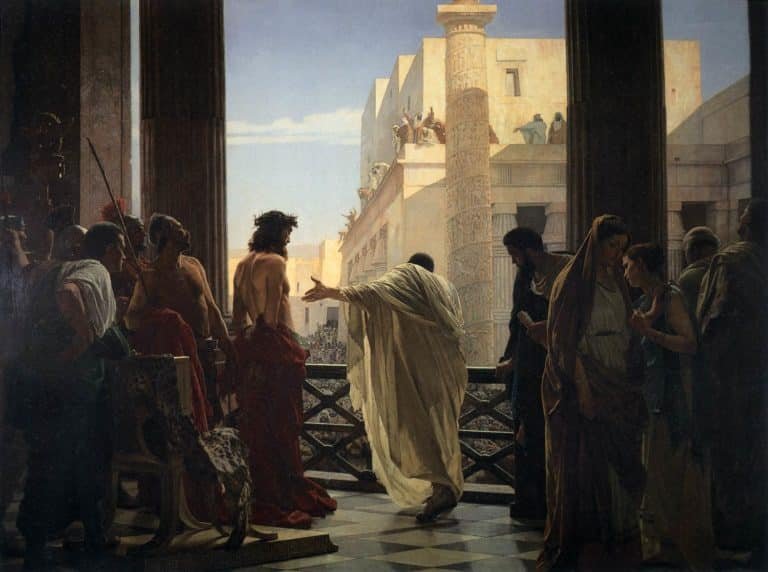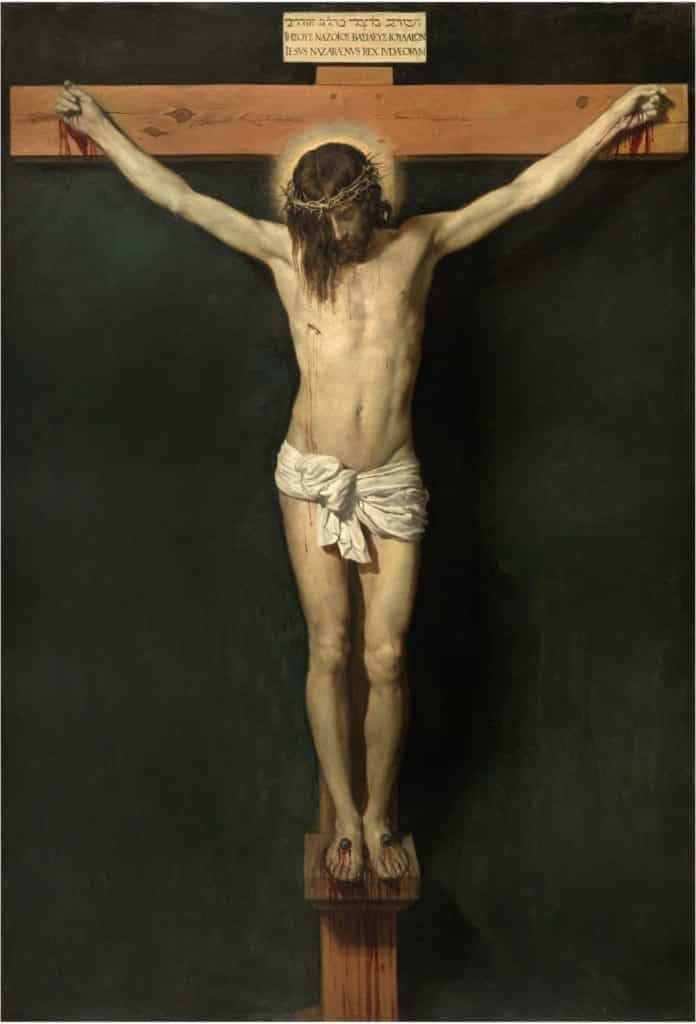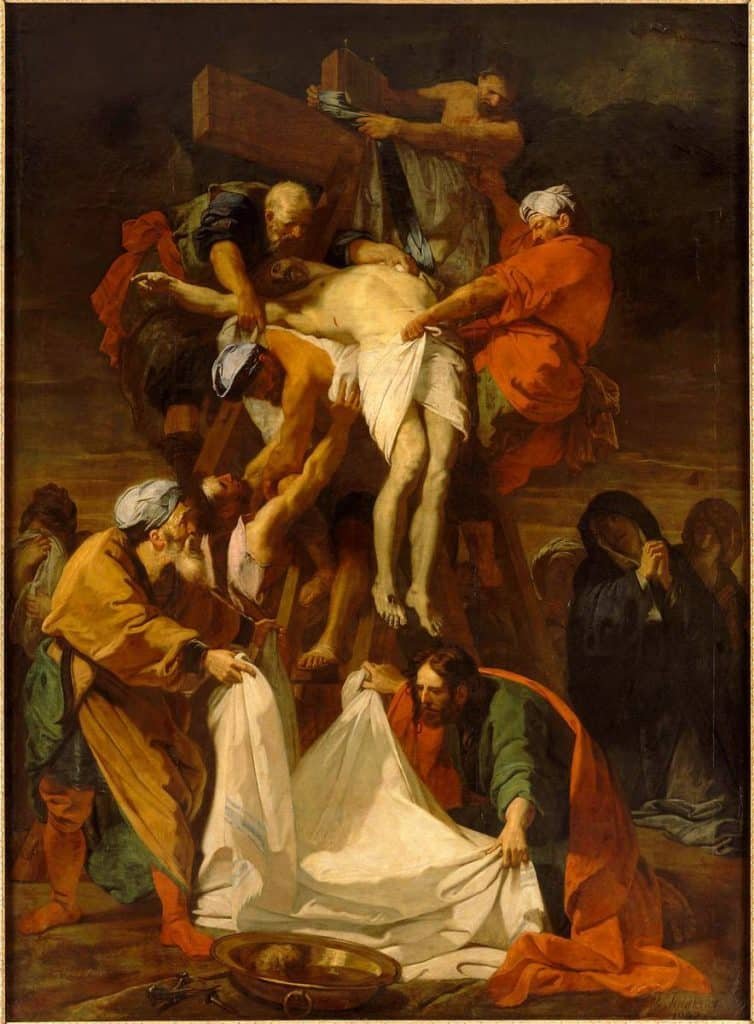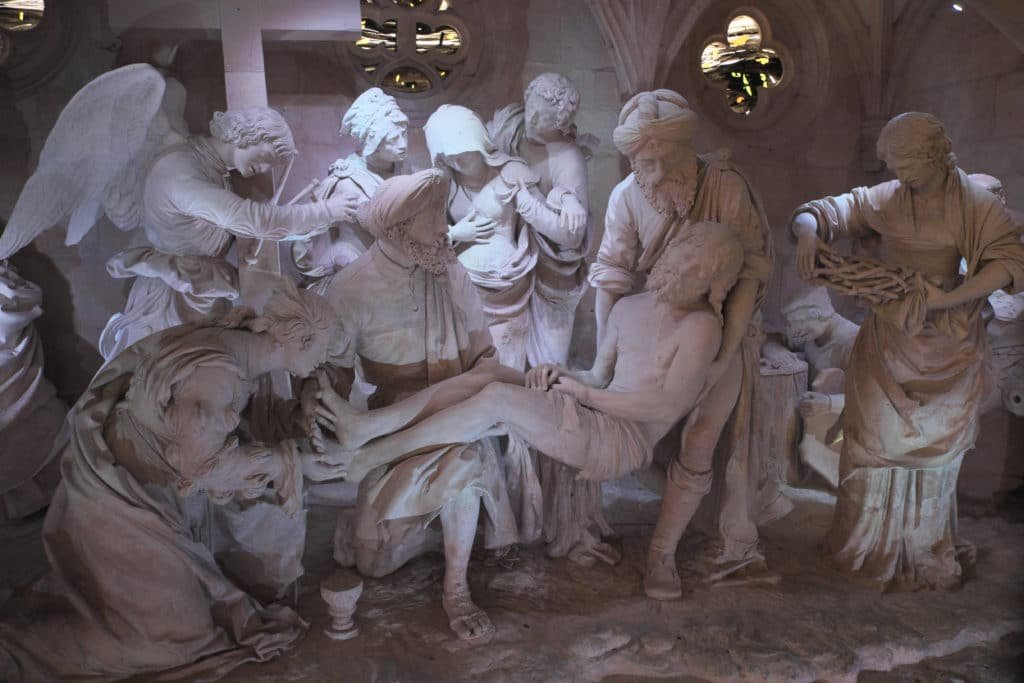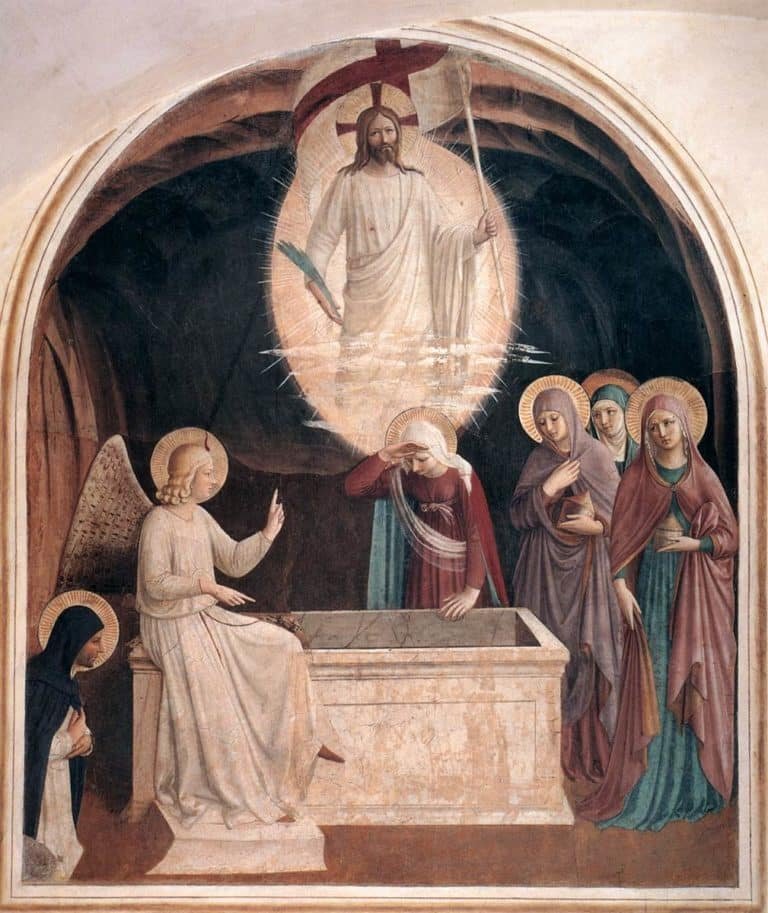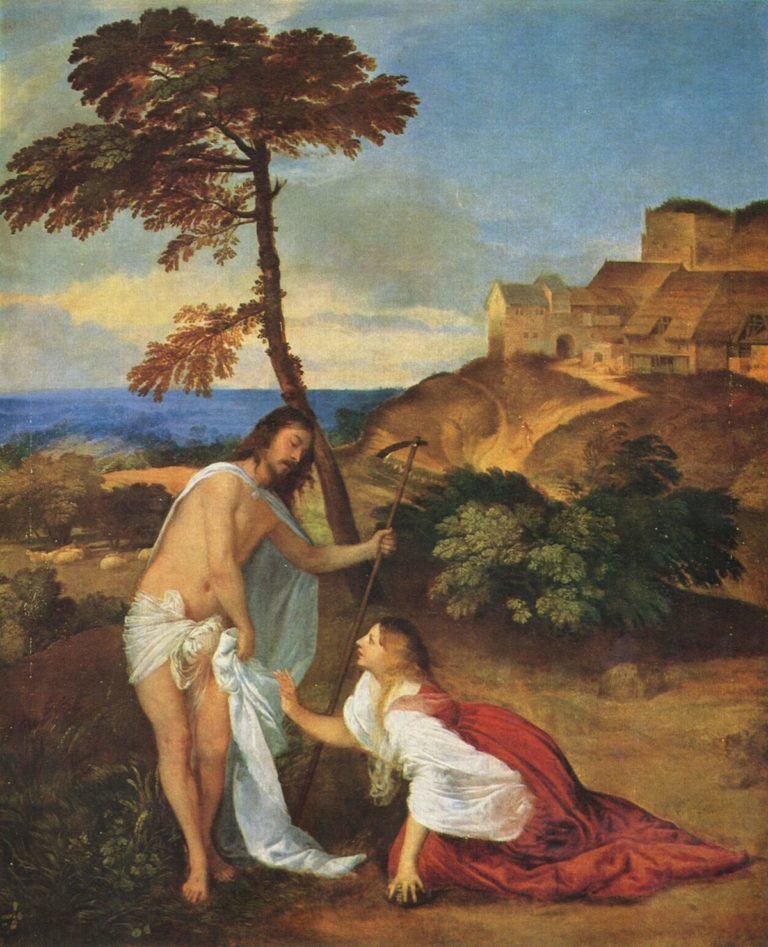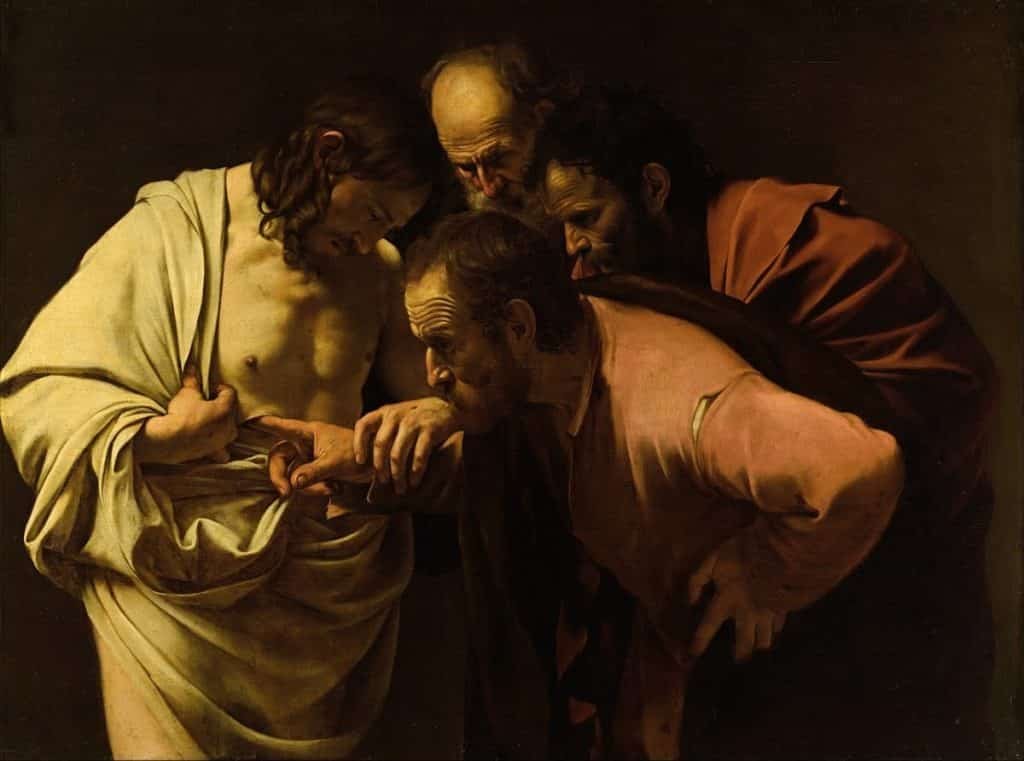Palm Sunday: Jesus’ Triumphal entry into Jerusalem
Christians call the week before Easter Holy Week. It starts with Palm Sunday, which commemorates Jesus’ entry into the city of Jerusalem, shortly before the Jewish celebration of Passover. Giotto represents Christ riding a donkey and welcomed by an overjoyed crowd waving palm branches and covering the path with their coats.
« And the multitudes that went before, and that followed, cried, saying, Hosanna to the Son of David: Blessed is he that cometh in the name of the Lord; Hosanna in the highest. And when he was come into Jerusalem, all the city was moved, saying, Who is this?And the multitude said, This is Jesus the prophet of Nazareth of Galilee. »
Gospel according to Matthew (21: 9-11)
Holy Monday: Cleansing of the Temple
On the following day, Jesus went to Herod’s Temple in Jerusalem. He was extremely angered to see the merchants occupying this place of prayer for commercial purposes. So he chased them from the sanctuary with a whip. This is one of the few episodes where Jesus is shown as impulsive and violent.
« And when he had made a scourge of small cords, he drove them all out of the temple, and the sheep, and the oxen; and poured out the changers’ money, and overthrew the tables; And said unto them that sold doves, Take these things hence; make not my Father’s house an house of merchandise. And his disciples remembered that it was written, The zeal of thine house hath eaten me up. Then answered the Jews and said unto him, What sign shewest thou unto us, seeing that thou doest these things? Jesus answered and said unto them, Destroy this temple, and in three days I will raise it up. »
Gospel according to John (2: 13-19).
Holy Wednesday: The Bargain of Judas
Holy Wednesday seems to have been devoted to rest after Jesus spending two days teaching his disciples in Bethany. One of them, however, contacted the High priests to organise his betrayal. Judas planned to hand Jesus over to the Jewish authorities who sought to eliminate him.
« Then one of the twelve, called Judas Iscariot, went unto the chief priests, And said unto them, What will ye give me, and I will deliver him unto you? And they covenanted with him for thirty pieces of silver. And from that time he sought opportunity to betray him. »
Gospel according to Matthew (26: 14-25)
Maundy Thursday: Jesus asks Peter and John to prepare for Passover
On the day of the Jewish Passover, Jesus asked his two apostles Peter and John to go find a place to celebrate. This minor scene is quite rarely represented in the history of art.
« Then came the day of unleavened bread, when the passover must be killed. And he sent Peter and John, saying, Go and prepare us the passover, that we may eat. »
Gospel according to Luke (22: 7-8)
Maundy Tuesday: The Last Supper
During the Passover meal, Jesus announced his imminent death to his twelve apostles, as well as his betrayal by one of them. He also invited them to eat bread, symbolising his body, and to drink wine, representing the blood he would come to shed.
« And his disciples went forth, and came into the city, and found as he had said unto them: and they made ready the passover. And in the evening he cometh with the twelve. And as they sat and did eat, Jesus said, Verily I say unto you, One of you which eateth with me shall betray me.
And they began to be sorrowful, and to say unto him one by one, Is it I? and another said, Is it I? And he answered and said unto them, It is one of the twelve, that dippeth with me in the dish. The Son of man indeed goeth, as it is written of him: but woe to that man by whom the Son of man is betrayed! good were it for that man if he had never been born.
And as they did eat, Jesus took bread, and blessed, and brake it, and gave to them, and said, Take, eat: this is my body. And he took the cup, and when he had given thanks, he gave it to them: and they all drank of it.
And he said unto them, This is my blood of the new testament, which is shed for many. Verily I say unto you, I will drink no more of the fruit of the vine, until that day that I drink it new in the kingdom of God. »
Gospel according to Mark (14: 16-25).
Leonardo da Vinci’s famous fresco shows Jesus seated at a table with his twelve apostles. They all seem shocked and disturbed by the announcement of the upcoming betrayal. On the left, Judas can be seen with his elbow on the table. His face is in the shadows, while in his hand he holds a purse containing the silver coins he received the day before…
Maundy Thursday: Agony in the Garden
After the feast, Jesus and his apostles went to Gethsemane, on the outskirts of the city of Jerusalem, to pray on the Mount of Olives.
« And when he was at the place, he said unto them, Pray that ye enter not into temptation. And he was withdrawn from them about a stone’s cast, and kneeled down, and prayed, Saying, Father, if thou be willing, remove this cup from me: nevertheless not my will, but thine, be done.
And there appeared an angel unto him from heaven, strengthening him. And being in an agony he prayed more earnestly: and his sweat was as it were great drops of blood falling down to the ground. And when he rose up from prayer, and was come to his disciples, he found them sleeping for sorrow, And said unto them, Why sleep ye? and pray, lest ye enter into temptation. »
Gospel according to Luke (22: 40-46)
The painter Andrea Mantegna shows several angels appearing to Jesus and presenting him with the instruments of his Passion. At his feet, Saints Peter, James and John are supposed to pray, but seem to have dozed off. Meanwhile, an army of soldiers, led by Judas, advances towards Jesus.
Maundy Thursday: Judas betrays Jesus
In this painting, Ugolino di Nerio depicts the infamous Kiss of Judas which allowed the soldiers to recognise Jesus of Nazareth.
« And while he yet spake, lo, Judas, one of the twelve, came, and with him a great multitude with swords and staves, from the chief priests and elders of the people. Now he that betrayed him gave them a sign, saying, Whomsoever I shall kiss, that same is he: hold him fast. And forthwith he came to Jesus, and said, Hail, master; and kissed him. And Jesus said unto him, Friend, wherefore art thou come? Then came they, and laid hands on Jesus, and took him.
And, behold, one of them which were with Jesus stretched out hishand, and drew his sword, and struck a servant of the high priest’s, and smote off his ear. Then said Jesus unto him, Put up again thy sword into his place: for all they that take the sword shall perish with the sword. Thinkest thou that I cannot now pray to my Father, and he shall presently give me more than twelve legions of angels? But how then shall the scriptures be fulfilled, that thus it must be? »
Gospel according to Matthew (26: 47-54)
On the left, Saint Peter is shown cutting off the ear of Malchus, a servant of the High Priest Caiaphas, although he seems here to use a razor blade rather than a sword.
Maundy Thursday and Good Friday: Jesus’ Trial
The three Synoptic Gospels (those of Saints Matthew, Mark and Luke) recount that the day after his arrest, Jesus was presented to various representatives of the Jewish authorities to decide on his fate. Albrecht Dürer shows Jesus, with both hands tied, led by two henchmen before Caiaphas, whom we have just mentioned:
« And they that had laid hold on Jesus led him away to Caiaphas the high priest, where the scribes and the elders were assembled. But Peter followed him afar off unto the high priest’s palace, and went in, and sat with the servants, to see the end. Now the chief priests, and elders, and all the council, sought false witness against Jesus, to put him to death; But found none: yea, though many false witnesses came, yet found they none. »
Gospel according to Matthew (26 : 57-60)
Conversely, Saint John’s account does not mention this council but recounts that Jesus was questioned by Annas, a former High Priest of Jerusalem, before being sent before Caiaphas. Both works of art highlight Jesus’ resigned attitude to his sentence, which seems to have been pronounced on the grounds of blasphemy.
Morning of Good Friday: The Denial of St Peter
During the trial, Saint Peter was questioned and accused of being a disciple of Jesus. Presumably not wishing to be associated to any form of scandal, he denied knowing him:
« But a certain maid beheld him as he sat by the fire, and earnestly looked upon him, and said, This man was also with him. And he denied him, saying, Woman, I know him not. And after a little while another saw him, and said, Thou art also of them. And Peter said, Man, I am not. And about the space of one hour after another confidently affirmed, saying, Of a truth this fellow also was with him: for he is a Galilaean. And Peter said, Man, I know not what thou sayest. And immediately, while he yet spake, the cock crew. And the Lord turned, and looked upon Peter. And Peter remembered the word of the Lord, how he had said unto him, Before the cock crow, thou shalt deny me thrice. »
Gospel according to Luke (22 : 56-61)
In a tenebrist style, Dutch painter Gerard Seghers shows Peter on the left, in the middle of a woman and a soldier. The apostle’s body language is clearly defensive, as a group of men turn away from their card game to listen to the conversation.
Morning of Good Friday: Ecce homo - Jesus before Pilate and the Flagellation
Since the Jewish authorities were not able to sentence Jesus to death, he was taken to Pontius Pilate. After questioning him, the Roman governor of Judea found no reason to carry out this sentence. He did have had him scourged – and Antonello of Messina delivers a movingly depiction of this passage. Subsequently, Pilate presented Jesus from his praetorium to the crowd, who was clamouring for him to be crucified.
« And the soldiers platted a crown of thorns, and put it on his head, and they put on him a purple robe, And said, Hail, King of the Jews! and they smote him with their hands. Pilate therefore went forth again, and saith unto them, Behold, I bring him forth to you, that ye may know that I find no fault in him. Then came Jesus forth, wearing the crown of thorns, and the purple robe. And Pilate saith unto them, Behold the man! When the chief priests therefore and officers saw him, they cried out, saying, Crucify him, crucify him. Pilate saith unto them, Take ye him, and crucify him: for I find no fault in him. The Jews answered him, We have a law, and by our law he ought to die, because he made himself the Son of God. »
Gospel according to John (19: 2-7)
Antonio Ciseri shows Pilate from behind, pointing to Christ by pronouncing the famous phrase “Ecce homo“, thus casting off any responsibility as to Jesus’ fate. In painting and sculpture, Ecce homo also designates devotional images of Jesus wearing the Crown of thorns.
Morning of Good Friday: Christ carrying the Cross
After his death sentence, Christ had to carry his cross to the place of his Crucifixion:
« And he bearing his cross went forth into a place called the place of a skull, which is called in the Hebrew Golgotha. »
« And as they led him away, they laid hold upon one Simon, a Cyrenian, coming out of the country, and on him they laid the cross, that he might bear it after Jesus. »
Gospel according to John (19: 17) & Gospel according to Luke (22: 26)
In this masterpiece by Renaissance painter Raphael, Simon of Cyrene is shown above the Cross. Jesus, meanwhile, has collapsed under its weight and turns his gaze towards his mother, the Virgin Mary, who holds out her arms towards him in a spasm of pain. She is surrounded by other holy figures, probably including Mary Magdelene, Marie of Jacob and Mary Salome.
Art history retained fourteen Stations of the Cross. Among the most frequently represented scenes, Christ is depicted with Saint Veronica, or speaking with women from Jerusalem.
Afternoon of Good Friday: The Crucifixion
Jesus’ execution is the culmination of the Passion of Christ. Death by crucifixion was considered particularly degrading. The extreme violence of this long ordeal made for a powerful image, frequently represented in the history of art. For Christians, it crystallises the pain and the sacrifice made by Jesus Christ who, through this gesture, is said to have washed humanity from its sins.
Diego Velázquez’s Crucified Christ shows a simple image of the event. The inscription above the cross illustrates the testimony of Saint John, while many depictions limit themselves to the initials INRI, from the Latin Iesvs Nazarenvs, Rex Ivdæorvm:
« And Pilate wrote a title, and put it on the cross. And the writing was, JESUS OF NAZARETH THE KING OF THE JEWS. This title then read many of the Jews: for the place where Jesus was crucified was nigh to the city: and it was written in Hebrew, and Greek, and Latin. »
Gospel according to John (19: 19-20)
Karel Dujardin’s canvas offers a more distant viewpoint, showing Christ on the Cross flanked by the good and the bad thief:
« And when they were come to the place, which is called Calvary, there they crucified him, and the malefactors, one on the right hand, and the other on the left. »
Évangile selon saint Luc (XXIII, 33)
The scene conveys a more dramatic atmosphere because, besides the depiction of many characters, including the Virgin and a group of women at the foot of the Cross, the sky is dark and stormy, in accordance with the story told by Saint Luke:
« And it was about the sixth hour [Ed: midday], and there was a darkness over all the earth until the ninth hour [Ed. 3 pm]. »
Gospel according to Luke (23: 44)
Evening of Good Friday: The Descent from the Cross
The theme of the Deposition, or the Descent from the Cross, gave rise to numerous works of art, especially since it facilitated very sophisticated compositions.
« And after this Joseph of Arimathaea, being a disciple of Jesus, but secretly for fear of the Jews, besought Pilate that he might take away the body of Jesus: and Pilate gave him leave. He came therefore, and took the body of Jesus. And there came also Nicodemus, which at the first came to Jesus by night, and brought a mixture of myrrh and aloes, about an hundred pound weight. »
Gospel according to John (19: 38-39)
In this monumental painting, painter Jean Jouvenet depicts five men descending Christ’s body from the Cross, probably including Nicodemus. As for Joseph of Arimathea, he stands at the bottom of the Cross, unfolding a shroud with Saint John. In the foreground, a basin filled with bloody water and four nails recall the violence of Christ’s death.
The Lamentation of Christ / Pietà
Although not mentioned in the Gospels, the iconography of Lamentation over the Body of Christ became a popular theme in the medieval art. The Madonna of Piety, or Pietà, is a derived subject matter. While Jean Jouvenet showed the weeping Virgin in the shadows, on the left of the Cross, Michelangelo made this central to his sculpture.
This intimate scene makes the death of Christ palpable. The Renaissance artist succeeds in rendering the heaviness of Jesus’ lifeless body, supported with dignity by his mother who looks down at her son and seems to display her son’s sacrifice to the viewer.
Evening of Good Friday: The Burial of Christ
Once taken down from the Cross, the body of Christ was buried near the place of his Crucifixion:
« Then took they the body of Jesus, and wound it in linen clothes with the spices, as the manner of the Jews is to bury. Now in the place where he was crucified there was a garden; and in the garden a new sepulchre, wherein was never man yet laid. »
Gospel according to John (19: 39-41)
This sculpted group by Ligier Richier comprises a total of thirteen figures and abundant details. The Virgin is swooning, meaning she has fainted from the pain, while being held up by two other characters. Nicodemus and Joseph of Arimathea support Christ’s corpse, while Mary Magdalene, recognisable thanks to her ointment jar, bends over to kiss his feet. On the right, a woman delicately presents the Crown of Thorns, while in the background, two men seem indifferent to the tragedy of the scene & play dice to win Jesus’ tunic.
Holy Saturday: The Descent into Limbo
According to some accounts, Christ descended into Hell, or Limbo between his Entombment and his Resurrection. In the canonical writings, only the First Epistle of Peter mentions Jesus “proclaiming to spirits in prison” (3:19). This mention was developed in the Apostles ’Creed in the 2nd century:
« He suffered under Pontius Pilate, was crucified, died, and was buried. He descended to the dead. On the third day he rose again. »
The apocryphal (ie. not officially recognised by the church) Gospel of Nicodemus also mentions this episode. But the history of art greatly contributed to anchoring this tradition. Jan Brueghel the Elder‘s interpretation shows a frightening vision of the underworld, full of lost souls tortured by demons. Jesus Christ appears in a halo of light that captures the viewer’s gaze. He extends his hand to one of these souls, while behind him stand Adam and Eve. Their presence, what’s more in the nude (meaning they are restored to their primordial innocence), seems to indicate Christ’s redemption of the Original Sin.
Easter Sunday: The Resurrection & Women at the Tomb
Easter Sunday celebrates the Resurrection of Christ. According to the Bible, the first witnesses of this miracle were the Holy Women who came to embalm the body of Christ.
« Now upon the first day of the week, very early in the morning, [women which came with Jesus from Galilee] came unto the sepulchre, bringing the spices which they had prepared, and certain others with them. »
Gospel according to Luke (24: 1)
The fresco, painted by Fra Angelico for the Convent of San Marco and completed by his disciple, Benozzo Gozzoli shows a group of women holding ointment jars, astonished to find an empty tomb.
« And, behold, there was a great earthquake: for the angel of the Lord descended from heaven, and came and rolled back the stone from the door, and sat upon it. His countenance was like lightning, and his raiment white as snow: And for fear of him the keepers did shake, and became as dead men. And the angel answered and said unto the women, Fear not ye: for I know that ye seek Jesus, which was crucified. He is not here: for he is risen, as he said. Come, see the place where the Lord lay. And go quickly, and tell his disciples that he is risen from the dead; and, behold, he goeth before you into Galilee; there shall ye see him: lo, I have told you. And they departed quickly from the sepulchre with fear and great joy; and did run to bring his disciples word. »
Gospel according to Matthew (28: 2-7)
At the top of the composition, the image of Jesus appears in a mandorla (almond shape framing a figure). In his hand, he holds the banner of victory bearing Saint George’s Cross.
Easter Sunday: Jesus appears to Mary Magdalene
According to Saint John, the risen Jesus appeared to Mary Magdalene in the Olive Garden in Gethsemane. A voice interrupted her flow of tears:
« Jesus saith unto her, Woman, why weepest thou? whom seekest thou? She, supposing him to be the gardener, saith unto him, Sir, if thou have borne him hence, tell me where thou hast laid him, and I will take him away. Jesus saith unto her, Mary. She turned herself, and saith unto him, Rabboni; which is to say, Master. Jesus saith unto her, Touch me not; for I am not yet ascended to my Father: but go to my brethren, and say unto them, I ascend unto my Father, and your Father; and to my God, and your God. »
Gospel according to John (20: 15-17)
In this masterpiece, Venetian master Titian shows Mary Magdalene trying to embrace Jesus while he pulls away. The viewer’s attention focuses on the interplay of gazes and gestures between both figures, which is highlighted by the landscape in the background. This iconographic theme is known as “Noli me tangere“, after the Latin translation of the words uttered by Jesus.
Easter Sunday: Supper at Emmaus
According to Saint Luke, Jesus also appeared to two disciples leaving Jerusalem to go to Emmaus. After catching up with them to walk by their side, he is said to have asked them the cause of their sadness, and listened to them recount their distress following the death of the “great prophet Jesus of Nazareth”. As they approached the village of Emmaus, Christ apparently attempted to move away, but was invited to stay and dine with them as evening drew closer:
« And it came to pass, as he sat at meat with them, he took bread, and blessed it, and brake, and gave to them. And their eyes were opened, and they knew him; and he vanished out of their sight. And they said one to another, Did not our heart burn within us, while he talked with us by the way, and while he opened to us the scriptures? »
Gospel according to Luke (24: 30-34)
Rembrandt was often the subject of the supper at Emmaus. Here, Jesus is breaking the bread, which is the most dramatic instant of the scene, the moment of revelation for the two pilgrims. The use of chiaroscuro gives a mysterious radiance to the figure of Christ, while reinforcing the magical atmosphere of the scene.
The Sunday after Easter: The Incredulity of Saint Thomas
Still according to Saint Luke, the two disciples of Emmaus returned to Jerusalem to inform the apostles of Christ’s Resurrection. While they were telling them what they had seen, Jesus himself suddenly appeared to them:
« But Thomas, one of the twelve, called Didymus, was not with them when Jesus came. The other disciples therefore said unto him, We have seen the Lord. But he said unto them, Except I shall see in his hands the print of the nails, and put my finger into the print of the nails, and thrust my hand into his side, I will not believe. And after eight days again his disciples were within, and Thomas with them: then came Jesus, the doors being shut, and stood in the midst, and said, Peace be unto you.
Then saith he to Thomas, Reach hither thy finger, and behold my hands; and reach hither thy hand, and thrust it into my side: and be not faithless, but believing. And Thomas answered and said unto him, My Lord and my God. Jesus saith unto him, Thomas, because thou hast seen me, thou hast believed: blessed are they that have not seen, and yet have believed. »
Gospel according to John (20: 24-27)
Using his typical tightly framed composition and side lighting, Caravaggio illustrates this episode with great dramatic intensity. The viewer’s attention is drawn to the hands of St. Thomas, who inserts a finger into the wound on Christ’s right side. The expression of stupor of Saint Thomas’s face is echoed in the curious, albeit more restrained, glances of the two other apostles. Jesus’ attitude, meanwhile, seems indulgent. His stigmata are also visible on his hands, surrounding those of the incredulous Thomas.




